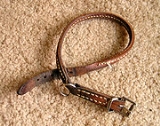
Dog collar
Encyclopedia
A dog collar is a is a piece of material put around the neck of a dog
. A collar might be used for control, identification, fashion, or other purposes. Identification tags and medical information is often placed on dog collars. Collars are also useful for controlling a dog manually, as they provide a handle for grabbing. Collars are often used in conjunction with a leash
, and a common alternative to a dog collar is a dog harness
. Dog collars are the most common form of directing and teaching dogs.
Dog collar is also an informal term for the clerical collar
used by Anglican vicar
s and other clergy.
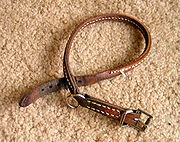
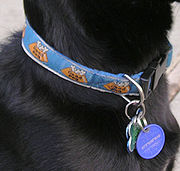
training, where a collar could get caught on equipment and strangle the dog). Each training collar has its own set of advantages and disadvantages (briefly outlined below) which trainers might consider before using a select one. Training collars are typically used for training only and not left on the dog's neck all the time, as some collars can be harmful or dangerous if left on a dog unsupervised.
 Slip collars (also called choke chains, slip chains, or choke collars) are a length of chain or nylon
Slip collars (also called choke chains, slip chains, or choke collars) are a length of chain or nylon
rope
with rings at either end such that the collar can be formed into a loop around the top of the dog's neck, just behind the ears. The ring which connects to the leash goes over the back of the dog's neck, not under.http://www.fsas.ca/DogInfo/Training/Slip_Collar.htm When the leash is attached to the dead ring the collar does not constrict on the dog's neck. When the leash is attached to the live ring the chain slips (adjusts) tighter when pulled and slips looser when tension is released. A quick jerk with an immediate release, euphemistically called a leash pop, snap, or correction, is used to coerce the dog into a 'heel' position.
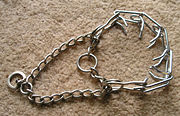 Prong collars (sometimes incorrectly termed 'pinch collars') are a series of chain links with blunted open ends turned towards the dog's neck. The design of the prong collar is such that it has a limited circumference unlike slip collars which do not have a limit on how far they can constrict on a dog's neck. The limited traction of the martingale chain combined with the angle of the prongs prevents the prongs moving close enough to pinch. The collar is designed to prevent the dog from pulling by applying pressure at each point against the dog's neck.
Prong collars (sometimes incorrectly termed 'pinch collars') are a series of chain links with blunted open ends turned towards the dog's neck. The design of the prong collar is such that it has a limited circumference unlike slip collars which do not have a limit on how far they can constrict on a dog's neck. The limited traction of the martingale chain combined with the angle of the prongs prevents the prongs moving close enough to pinch. The collar is designed to prevent the dog from pulling by applying pressure at each point against the dog's neck.
Prong collars must never be turned inside out (with the prongs facing away from the dog's skin), as this may cause injury against the body and head. http://www.luvmydog.co.uk/acatalog/caps_pic.html Plastic tips are occasionally placed on the ends of the prongs to protect against tufts forming in the fur or, in the case of low quality manufactured collars with rough chisel cut ends, puncturing the skin. Like the slip collar, the prong collar is placed high on the dog's neck, just behind the ears, at the most sensitive point.http://www.leerburg.com/fit-prong.htm
Some dogs can free themselves from prong collars with large wire looped sides by shaking their head so that the links pop out, so some trainers have come to use a second collar (usually an oversize slip collar) in addition to the prong collar so when this happens the dog does not run loose.
 Martingale collars
Martingale collars
are recommended for Sighthound
s because their heads are smaller than their necks and they can often slip out of standard collars. They can, however, be used for any breed of dog. Their no-slip feature has made them a safety standard at many kennels and animal shelters. A martingale collar has 2 loops; the smaller loop is the "control loop" that tightens the larger loop when pulled to prevent dogs from slipping out of the collar. Similar to a prong collar, the martingale has limited constriction on the dog's neck and applies even pressure.
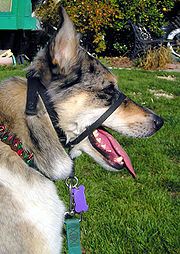 Head halters, sold under the brand names Halti or Gentle Leader or Snoot Loop, are similar in design to a halter for a horse. This device fastens around the back of the neck and over the top of the muzzle, giving more control over a dog's direction and the intensity of pulling on a leash than collars that fit strictly around the neck. Pressure on this type of collar pulls the dog's head towards the handler.
Head halters, sold under the brand names Halti or Gentle Leader or Snoot Loop, are similar in design to a halter for a horse. This device fastens around the back of the neck and over the top of the muzzle, giving more control over a dog's direction and the intensity of pulling on a leash than collars that fit strictly around the neck. Pressure on this type of collar pulls the dog's head towards the handler.
Those who do not recommend use of the head halter say that some dogs find it unnatural and uncomfortable. If the collar is too tight, it may dig too deeply into the skin or the strap around the muzzle may push into the dog's eyes. Cranial injury is a possible result from improper use of the head halter; if a dog is jerked suddenly by the leash attached to the head halter, the dog's neck is pulled sharply to the side, which might result in neck injury (though this can be true of all collars). If the nose strap is fitted too tightly, the hair on the muzzle can also be rubbed off, or the dog might paw and scratch at its face, causing injuries ranging from mere bare skin to severe abrasions.
s (or training collars, remote training collars, e-collars, electronic collars and hunting collars) are electronic training aids developed to deliver an electrical signal, vibration, tone, through contact points attached to a dog collar.
s or protection collars are metal collars fitted with large spikes radiating away from the dog, usually worn by dogs protecting livestock
in case they are attacked by wolves or other predators. Such collars protect the neck of a dog from direct attack. It is rare to see these collars being used in modern societies.
designed for dogs. Although it is not designed to be used as a life preserver
or life jacket, it can provide additional buoyant support for the head of a dog when in the water. It is often used in canine hydrotherapy
services to assist in the rehabilitation of injured dogs. The collar may be constructed of closed cell foam material that is inherently buoyant or be of a type that is inflated with air.
Dog
The domestic dog is a domesticated form of the gray wolf, a member of the Canidae family of the order Carnivora. The term is used for both feral and pet varieties. The dog may have been the first animal to be domesticated, and has been the most widely kept working, hunting, and companion animal in...
. A collar might be used for control, identification, fashion, or other purposes. Identification tags and medical information is often placed on dog collars. Collars are also useful for controlling a dog manually, as they provide a handle for grabbing. Collars are often used in conjunction with a leash
Leash
A leash is a rope or similar material attached to the neck or head of an animal for restraint or control...
, and a common alternative to a dog collar is a dog harness
Dog harness
A dog harness is piece of equipment for dogs, generally similar to harness tack for horses. There are various designs depending on the type of use, whether it be for assistance to a disabled person, hauling a cart or sled, or pulling a human being, such as in skijoring or pulka...
. Dog collars are the most common form of directing and teaching dogs.
Dog collar is also an informal term for the clerical collar
Clerical collar
A clerical collar is an item of Christian clerical clothing. It is a detachable collar that buttons onto a clergy shirt or rabbat , being fastened by two metal studs, one attached at the front and one at the back to hold the collar to the shirt. The collar closes at the back of the neck, presenting...
used by Anglican vicar
Vicar
In the broadest sense, a vicar is a representative, deputy or substitute; anyone acting "in the person of" or agent for a superior . In this sense, the title is comparable to lieutenant...
s and other clergy.
Basic collars

- Buckle collars, also called flat collars, are usually made of nylon webbing or leather (less common materials can include polyester, hempHempHemp is mostly used as a name for low tetrahydrocannabinol strains of the plant Cannabis sativa, of fiber and/or oilseed varieties. In modern times, hemp has been used for industrial purposes including paper, textiles, biodegradable plastics, construction, health food and fuel with modest...
, or metal) with a buckle similar to a belt buckle, or a quick-release buckle, either of which holds the collar loosely around the dog's neck. Identification is commonly attached to such a collar; it also comes with a loop to which a leash can be fastened.

- Flea collars are impregnated with chemicals that repel fleaFleaFlea is the common name for insects of the order Siphonaptera which are wingless insects with mouthparts adapted for piercing skin and sucking blood...
s. They are usually a supplementary collar, worn in addition to the conventional buckle collar. - Elizabethan collarElizabethan collarAn Elizabethan collar or space collar is a protective medical device worn by an animal, usually a cat or dog...
s, shaped like a truncated cone, can be fitted on a dog to prevent it from scratching a wound on its head or neck or licking a wound or infection on its body. - Break-away collars look similar to buckle collars, but have a safety mechanism installed that allows the dog to break free of the collar if excessive force is applied. These collars are useful in situations where a non-quick release collar could get snagged and strangle the dog.
- Safety Stretch Collars an elastic panel in the sturdy nylon collar allows escape from potential strangulation dangers such as branches, fences, gates and other dogs. Unlike breakaways a stretch collar acts like a traditional static collar when clipped with a leash.
- Stud collars are leather collars fitted with dulled points and/or metal studs that traditionally prevented another animal from biting the dog's neck. In modern societies, stud collars are more commonly considered a fashion accessory.
Training collars
Several types of collars are used for the purposes of training dogs, though sometimes a collar is not used at all (such as in the case of dog agilityDog agility
Dog agility is a dog sport in which a handler directs a dog through an obstacle course in a race for both time and accuracy. Dogs run off-leash with no food or toys as incentives, and the handler can touch neither dog nor obstacles...
training, where a collar could get caught on equipment and strangle the dog). Each training collar has its own set of advantages and disadvantages (briefly outlined below) which trainers might consider before using a select one. Training collars are typically used for training only and not left on the dog's neck all the time, as some collars can be harmful or dangerous if left on a dog unsupervised.
Slip collars

Nylon
Nylon is a generic designation for a family of synthetic polymers known generically as polyamides, first produced on February 28, 1935, by Wallace Carothers at DuPont's research facility at the DuPont Experimental Station...
rope
Rope
A rope is a length of fibres, twisted or braided together to improve strength for pulling and connecting. It has tensile strength but is too flexible to provide compressive strength...
with rings at either end such that the collar can be formed into a loop around the top of the dog's neck, just behind the ears. The ring which connects to the leash goes over the back of the dog's neck, not under.http://www.fsas.ca/DogInfo/Training/Slip_Collar.htm When the leash is attached to the dead ring the collar does not constrict on the dog's neck. When the leash is attached to the live ring the chain slips (adjusts) tighter when pulled and slips looser when tension is released. A quick jerk with an immediate release, euphemistically called a leash pop, snap, or correction, is used to coerce the dog into a 'heel' position.
Prong collar

Prong collars must never be turned inside out (with the prongs facing away from the dog's skin), as this may cause injury against the body and head. http://www.luvmydog.co.uk/acatalog/caps_pic.html Plastic tips are occasionally placed on the ends of the prongs to protect against tufts forming in the fur or, in the case of low quality manufactured collars with rough chisel cut ends, puncturing the skin. Like the slip collar, the prong collar is placed high on the dog's neck, just behind the ears, at the most sensitive point.http://www.leerburg.com/fit-prong.htm
Some dogs can free themselves from prong collars with large wire looped sides by shaking their head so that the links pop out, so some trainers have come to use a second collar (usually an oversize slip collar) in addition to the prong collar so when this happens the dog does not run loose.
Martingale collar

Martingale (collar)
A martingale is a type of dog collar that provides more control over the animal without the choking effect of a slip collar. It is similar in concept to a horse's martingale....
are recommended for Sighthound
Sighthound
Sighthounds, also called gazehounds, are hounds that primarily hunt by speed and sight, instead of by scent and endurance as scent hounds do.-Appearance:...
s because their heads are smaller than their necks and they can often slip out of standard collars. They can, however, be used for any breed of dog. Their no-slip feature has made them a safety standard at many kennels and animal shelters. A martingale collar has 2 loops; the smaller loop is the "control loop" that tightens the larger loop when pulled to prevent dogs from slipping out of the collar. Similar to a prong collar, the martingale has limited constriction on the dog's neck and applies even pressure.
Head halters

Controversy
Supporters of the head halter say that it enables the handler to control the dog's head, and makes the dog unable to pull using its full strength. It is especially useful with reactive dogs, when control of the dog's head can be a safety issue.Those who do not recommend use of the head halter say that some dogs find it unnatural and uncomfortable. If the collar is too tight, it may dig too deeply into the skin or the strap around the muzzle may push into the dog's eyes. Cranial injury is a possible result from improper use of the head halter; if a dog is jerked suddenly by the leash attached to the head halter, the dog's neck is pulled sharply to the side, which might result in neck injury (though this can be true of all collars). If the nose strap is fitted too tightly, the hair on the muzzle can also be rubbed off, or the dog might paw and scratch at its face, causing injuries ranging from mere bare skin to severe abrasions.
Shock collars
Shock collarShock collar
The term shock collar is a term used in order to describe a family of training collars that deliver shocks of varying intensity and duration to the neck of a dog via a radio controlled electronic device...
s (or training collars, remote training collars, e-collars, electronic collars and hunting collars) are electronic training aids developed to deliver an electrical signal, vibration, tone, through contact points attached to a dog collar.
Wolf collars
Wolf collarWolf collar
A wolf collar is a type of dog collar that is designed to protect dogs from wolves. Wolf collars are fitted with elongated spikes to stop wolves from attacking dogs on the neck. Such collars are mainly used in countries such as Turkey and Spain, where they are known as carlancas.-Use:A wolf collar...
s or protection collars are metal collars fitted with large spikes radiating away from the dog, usually worn by dogs protecting livestock
Livestock
Livestock refers to one or more domesticated animals raised in an agricultural setting to produce commodities such as food, fiber and labor. The term "livestock" as used in this article does not include poultry or farmed fish; however the inclusion of these, especially poultry, within the meaning...
in case they are attacked by wolves or other predators. Such collars protect the neck of a dog from direct attack. It is rare to see these collars being used in modern societies.
JASA Force Collar
A force collar is a leather collar with metal prongs staggered along the inside; similar to a prong collar.Lighted Collar
A lighted collar (or collar light, dog light) is a collar that emits light in order to make a dog more visible in the dark to their owners and more importantly, nearby motorists. It should be noted that it is not designed to help a dog see at night, as it is well documented that dogs have very good vision in low light conditions.Most lighted collars utilize one or more light emitting diodes for the light source and can be of virtually any color, although red and blue are most common. Power is provided by one or more batteries, most common types being AAA and lithium coin cells to minimize the added weight to the collar.Flotation collar
A flotation collar (or buoyant collar) is a buoyancy aidBuoyancy aid
Buoyancy aids are a specialist form of personal flotation device used most commonly by kayakers, canoeists and dinghy sailors. They are designed as a flotation aid, rather than a life-saving device and have several key differences to other PFD's and life-jackets.Canoeing and kayaking buoyancy aids...
designed for dogs. Although it is not designed to be used as a life preserver
Life preserver
Life preserver or Life-preserver may refer to:*Personal flotation device*Lifebuoy, a ring-shaped flotation device*A kind of club...
or life jacket, it can provide additional buoyant support for the head of a dog when in the water. It is often used in canine hydrotherapy
Canine hydrotherapy
Canine hydrotherapy is a form of hydrotherapy directed at the treatment of chronic conditions, post-operative recovery, and pre-operative or general fitness in dogs.-Background:...
services to assist in the rehabilitation of injured dogs. The collar may be constructed of closed cell foam material that is inherently buoyant or be of a type that is inflated with air.
See also
- CollarCollar (animal)An animal collar is a device that attached to the neck of an animal to allow it to be harnessed, tied up or for various other reasons.*Pet collar. A piece of material put around the neck of certain pet animals, such as dogs or cats, for control, identification, or other purposes. Identification...
- Shock collarShock collarThe term shock collar is a term used in order to describe a family of training collars that deliver shocks of varying intensity and duration to the neck of a dog via a radio controlled electronic device...
- The Dog Collar Museum at Leeds Castle, Kent, England

